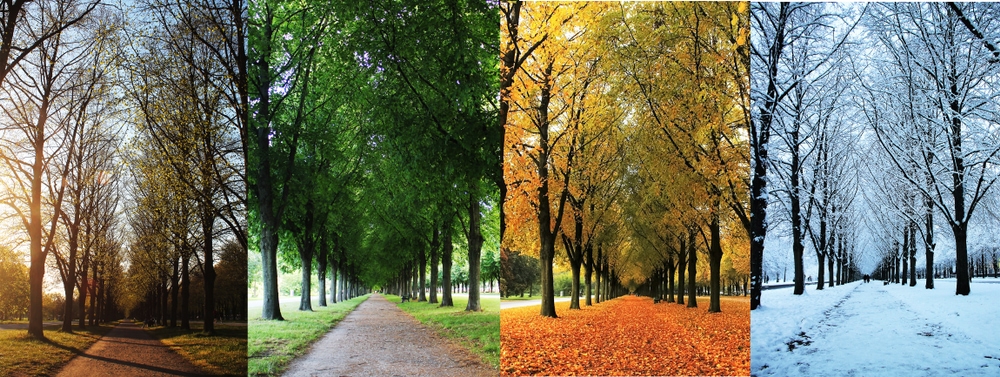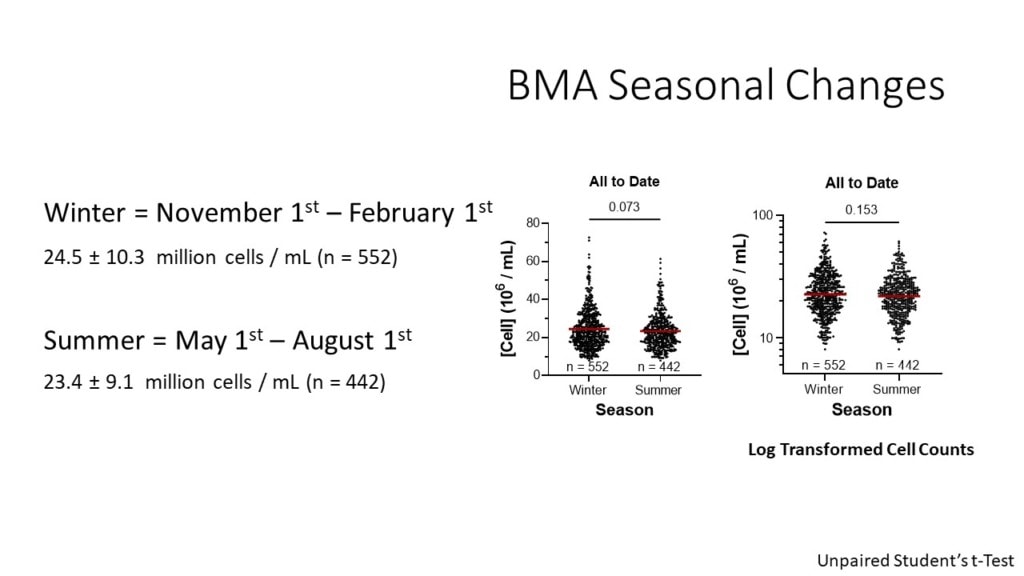Does the Season Impact a Bone Marrow Draw?

Credit: Shutterstock
Several months ago, during one of our weekly Friday Facebook Live events, a patient asked a super interesting question. What did they ask? If the season of your bone marrow draw impacted the recovery of cells. Let’s dig in.
BMA 101
A Bone Marrow Concentrate (BMC) procedure contains your own stem and other cells and is used to treat many different musculoskeletal conditions. That’s made from a bone marrow aspirate (BMA), which is obtained by aspirating bone marrow from the back of the pelvis. The stem cell fractions within that aspirate are concentrated via centrifugation to make BMC.
The TNCC Count
The BMC and BMA contain lots of cells types. Based on our published research, a rough surrogate for the number of stem cells in these samples is the total number of nucleated cells (1). Depending on the sex, age, and size of the patient as well as the technique used, that number, called a TNCC (Total Nucleated Cell Count) ranges from about 400 million to 2 billion cells. Again, that’s NOT a stem cell count, but merely the total number of cells in the sample of which a small percentage are stem cells.
What’s a Good TNCC?
The only area where we have seen TNCC matter so far is in treating knee arthritis where based on our published work, we see better results if the TNCC is over 400 million (2). We investigate constantly if the TNCC or other dose metrics matter in other applications and if we find more, we’ll let everyone know. For example, we’re running down one correlation now that showed up in a tendon healing study. Making that real will take another few months of work. We’re also getting ready to publish another dose metric for knee OA.
Measuring TNCC
If you want to separate a novice or part-time physician performing regen med from an expert, one of the differentiators is knowing the dose. That would seem to be very critical as after all, in no other area of medicine is it OK not to know the dose. Yet, 99% of the doctors who use Bone Marrow Concentrate don’t have the ability to know how many cells are going into the patient. As discussed above, in knees that’s a big problem. However, at Regenexx we measure the TNCC in every patient.
TNCC and Season?
A patient at one of our Facebook Lives asked an interesting question. Since Vitamin D levels in northern altitudes go down in the winter, which can impact stem cell function and things like bone density, is getting a Bone Marrow Concentrate procedure in the summer better than in the winter? That question hit me as totally insightful and possibly relevant.
Given that we have all of this data, I knew we could easily answer this question. Hence, one of our scientists looked at this issue and produced this graph:

The collection of dots represent the TNCC per ml of the BMA in patients in either the 6 months containing winter or the 6 months containing summer. After looking at almost a thousand patient samples, there was no significant difference in the TNCC’s between these two seasons. Hence, it makes little difference if you get a procedure in the cold of winter or the heat of summer!
Why Do This?
At our Colorado HQ, we have a full university-level research lab. We also cryopreserve a sample of every bone marrow aspiration for every patient procedure we perform. That’s all very expensive.
Why take the time to answer questions like this? Because this is the little stuff that defines an entire medical specialty. Meaning that experts in a real area of medical study know the answers to commonsense questions like this one.
Sharing Our Data
This data really isn’t worth publishing as to get it into that form and submit it and then go through peer review would take us away from other mission-critical projects on the docket. Hence, we are freely sharing here for all to see and to benefit from.
The upshot? Don’t worry about the season of your Bone Marrow Concentrate procedure! If it’s hot or cold outside, the dose will be the same.
[A special thanks to our lab team and especially Dustin Berger for putting all of this together! Dustin has a gift for digging into hard questions and never trusting his assumptions, which is what makes a researcher great. If you have the tools to look, the data shows you the answers.]
__________________________________
References:
(1) Berger DR, Aune ET, Centeno CJ, Steinmetz NJ. Cryopreserved bone marrow aspirate concentrate as a cell source for the colony-forming unit fibroblast assay. Cytotherapy. 2020 Sep;22(9):486-493. doi: 10.1016/j.jcyt.2020.04.091. Epub 2020 Jun 19. PMID: 32565131.
(2) Centeno CJ, Al-Sayegh H, Bashir J, Goodyear S, Freeman MD. A dose response analysis of a specific bone marrow concentrate treatment protocol for knee osteoarthritis. BMC Musculoskelet Disord. 2015 Sep 18;16:258. doi: 10.1186/s12891-015-0714-z. PMID: 26385099; PMCID: PMC4575428.

NOTE: This blog post provides general information to help the reader better understand regenerative medicine, musculoskeletal health, and related subjects. All content provided in this blog, website, or any linked materials, including text, graphics, images, patient profiles, outcomes, and information, are not intended and should not be considered or used as a substitute for medical advice, diagnosis, or treatment. Please always consult with a professional and certified healthcare provider to discuss if a treatment is right for you.
